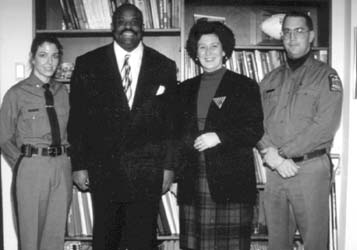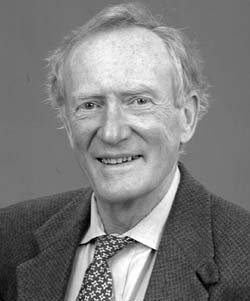

By Lisa James
The times are definitely changing. Just ask anyone who has dealt with the University Police Department (UPD) lately. As part of a department-wide shift to a more community-based way of operating, many new initiatives have been implemented to better connect with the University’s students, faculty, staff and visitors. The model that has been developed, under the direction of UPD Chief J. Frank Wiley, is consistent with that of the International Association of Chiefs of Police.
Among some of the new programs is the Client Satisfaction Survey, which is given to anyone who has had contact with UPD. It allows people to rate the Department’s performance on everything from how long it took them to answer the phone to whether the responding officer was friendly and understanding. According to Wiley, all of the survey respondents have given very favorable reviews.
Another successful aspect of the community-based system has been the Park, Walk and Talk program, where the officers get out of their patrol cars and interact more with people. “It is a matter of increased emphasis away from traditional patrol procedures,” said Tom Kilcullen, an assistant chief of police. “We have also emphasized to the officers that the most valuable activities are those in which they make direct personal contact with the public.” A result of this has been that the officers feel more like a viable part of the University community through this increased interaction.
Officers are now required to fill out a daily activities sheet, which is intended to encourage more of the type of behavior that is consistent with the new community-policing model. The sheet includes a variety of activities which officers normally perform, plus a few extras, and assigns a numerical value to each. At the end of the shift, the numbers are added up. For example, an officer gets three points for a crime report, five points for a directed patrol, and one point for every two “gotcha” tags they hand out. “When we find an unattended purse or an unlocked door, one of these ægotcha `hang-tags are left there to remind the owner about leaving belongings unattended,” Wiley said.
In addition, Directed Patrols, where officers are assigned to be at a specific place at a specific time, such as the walkways between the podium and the parking lots when classes end, is also a new feature.
Some of the programs begun through this new way of operating are less formal. In partnership with the Student Association, the UPD staff hosted a social for many student groups on November 14. The students got the chance to meet many of the officers as well as the personnel from the department that they do not normally have any contact with.
Last year, an Affirmative Action Outreach Program was started to retain three students to create a program that would increase contact between underrepresented student populations and UPD. These students will develop a program which can be presented to officers that will give them an idea of what it like to be a member of an underrepresented group. By doing this, they will hopefully understand some of the difficulties and learn how those difficulties can lead to conflict. “This will help because after this training, when an officer is called in on a situation, they can better understand the origins of the problem and perhaps realize why it is happening,” said Doug Kern, an assistant chief of the UPD. “We are also in the process of forming a university-wide Campus Advisory Committee, which will consist of faculty, staff and students,” Wiley said.
“There are two elements to creating a safe community,” Kern said. “One is reducing crime. The second is reducing the perception of crime or the sense of insecurity.” By increasing the police presence, the public constantly sees officers and so do criminals. In this way, you not only decrease crime but increase the perception of safety. “A fear reduction campaign is an important part of any community-policing model,” Wiley added.
Jim Doellefeld, Vice President for Student Affairs, said, “This shift to community policing will lead to a very safe learning environment and a condition whereby everyone has a stake in the safety and well-being of the University community.”

By Linda Chavis
At its October 1996 annual meeting in Denver, Colo., the Geological Society of America presented its Career Contribution Award for “achievements that have led to major advances in the fields of structural geology and tectonics” to Winthrop Means of the Department of Earth and Atmospheric Sciences.
The Citation cites Means’ two influential textbooks: Stress and Strain: Basic Concepts of Continuum Mechanics for Geologists and An Outline of Structural Geology; his effective simplification of complex subjects; his invention of novel experiments which permit watching grain-scale deformation processes through a microscope; and his prominence as a reviewer for journals.
Means came to Albany in 1965, before the present Earth Science Building was completed. He has served as department chairman and has long been active in University affairs.
He recalls the days when his love of geology began. “I always liked outdoor activities, such as walking in the mountains,” he said. “What really added to this was when my father took me to collect mineral samples in rock quarries near Paterson, New Jersey. It was then that I got hooked on crystals.”
Some of Means’ recent work with graduate student Youngdo Park will be on display in a forthcoming new “Earth Science Hall” at the Smithsonian Institution in Washington. In support of the exhibit, a film crew from the Smithsonian was on campus last May for two days to record activities in Means’ microstructural geology lab.
The Citationist for the GSA award, D. DePaor, noted that Means’ only “shortcoming” is his professional modesty. “He has no real understanding of the value of his own work nor any appreciation of the importance of his community service contributions in our science,” said DePaor, a professor at Harvard University. “He may even try to tell you he has not been terribly productive or that his interests have been esoteric . . . Pay no attention to him!”
Felony crimes dropped 67.4 percent during September and October, compared with the same two months of a year ago, according to University Police Chief Frank Wiley.
During the 60-day period there were 14 reported felonies committed, as contrasted with 43 cases for the same period last year. The number of burglaries - the most prevalent felony reported - dropped from 23 to 5, a reduction of 78.3 percent.
Robberies dropped from 3 to none; and reported assaults remained steady at 4. Motor vehicle theft remained constant at zero. The only increase was reported in aggravated harassment cases, which went up from 33 to 47, a 29.8 percent increase. There were no murders or rapes reported.
“The decrease in felonies, particularly in robbery and burglary, can be attributed to tactical deployment, increased foot patrols, community education, and directed patrols. Park, Walk and Talk patrols have increased in the reporting period from 713 to 1,178, or up 65.2 percent,” Wiley said. “I would also like to add that the client satisfaction surveys have yet to reveal a single unsatisfactory rating, an accomplishment virtually unheard of in population as diverse and progressive as ours.”
According to the chief, careful case management and improved preliminary investigations have led to an overall clearance rate of 35.7 percent of the 230 reported criminal cases, which is twice the national average.
“Moreover, I am very pleased to report a 100 percent follow-up rate. A special commendation goes to Senior Investigator Jack Ruth and Investigator Garry Slyke for the excellent performance of the investigative unit,” Wiley concluded.